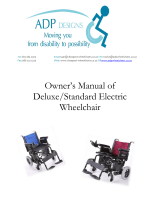Contents
Contents ..................................................................................................................... 1
Preface........................................................................................................................ 2
1 Your product .................................................................................................. 3
1.1 Accessories .................................................................................................... 3
2 Before use ..................................................................................................... 4
2.1 Intended use ................................................................................................... 4
2.2 General safety instructions ............................................................................. 4
2.3 Symbols on the wheelchair ............................................................................. 5
2.4 Transport ......................................................................................................... 5
2.5 First use and storage ...................................................................................... 8
3 Using your wheelchair .................................................................................. 9
3.1 First ride .......................................................................................................... 9
3.2 Driving outdoors .............................................................................................. 9
3.3 Operating console ......................................................................................... 10
3.4 Brake and free-wheel lever ........................................................................... 11
3.5 Moving to/from wheelchair ............................................................................ 12
3.6 Comfort adjustments ..................................................................................... 13
3.7 Battery status and charging .......................................................................... 15
4 Maintenance ................................................................................................ 17
4.1 Time of maintenance..................................................................................... 17
4.2 Instructions for maintenance ......................................................................... 18
4.3 Troubleshooting ............................................................................................ 18
4.4 Expected lifespan .......................................................................................... 19
4.5 Reuse ........................................................................................................... 19
4.6 End of use ..................................................................................................... 19
5 Technical specifications ............................................................................. 20






















